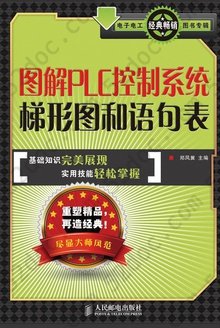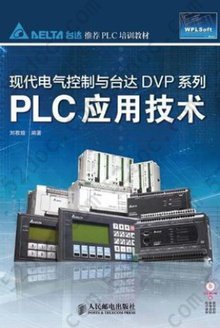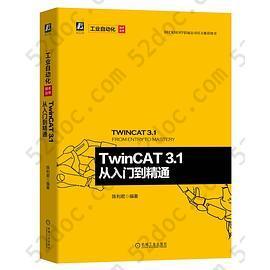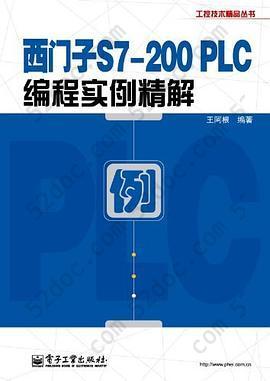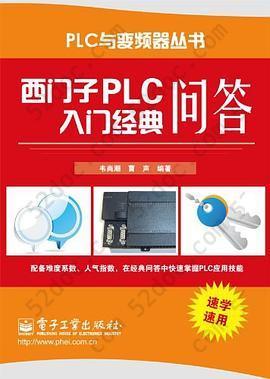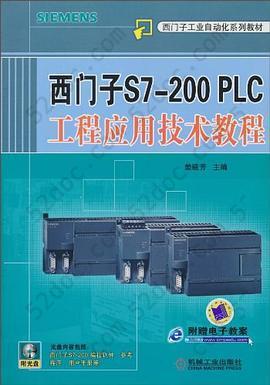注重体验与质量的电子书资源下载网站
分类于: 编程语言 互联网
简介

Programmable Logic Controllers: A Practical Approach to IEC 61131-3 using CODESYS 豆 0.0分
资源最后更新于 2020-11-20 04:48:10
作者:Dag Hakon Hanssen
出版社:WILEY
出版日期:2015-01
ISBN:9781118949245
文件格式: pdf
简介· · · · · ·
IEC61131-3 is the attempt by the industry automation community to unify the programming language and methodology for PLC. This book offers a through introduction to the PLC itself, the basic idea of programming a PLC for a control process, and the implementation of these general concepts using CODESYS software, which is a widely recognized instance of the IEC61131-3 standard.
目录
Part One: Hardware
1 About PLCs
1.1 History
1.2 Structure
1.3 PLC Operation
1.4 Test Problems
2 Digital Signals and Digital Inputs and Outputs
2.1 Introduction
2.2 Terminology
2.3 Switches
2.4 Logical Sensors
2.5 Connection of Logical Sensors
2.6 Properties of Discrete Inputs
2.7 Discrete Actuators
2.8 Test Problems
3 Analog Signals and Analog I/O
3.1 Introduction
3.2 Digitalization of Analog Signals
3.3 Analog Instrumentation
3.4 Temperature Sensors
3.5 Connection
3.6 Properties of Analog Input Modules
3.7 Analog Output Modules and Standard Signal Formats
3.8 Test Problems
Part Two : Methodic
4 Structured Design
4.1 Introduction
4.2 Number Systems
4.3 Digital Logic
4.4 Boolean Design
4.5 Sequential Design
4.6 State-Based Design
4.7 Summary
4.8 Test Problems
Part Three: IEC 61131-3
5 Introduction to Programming and IEC 61131-3
5.1 Introduction
5.2 Brief Presentation of the Languages
5.3 Program Structure in IEC 61131-3
5.4 Program Processing
5.5 Test Problems
6 IEC 61131-3: Common Language Elements
6.1 Introduction
6.2 Identifiers, Keywords, and Comments
6.3 About Variables and Data Types
6.4 Pragmas and Literals
6.5 Data Types
6.6 Variables
6.7 Direct Addressing
6.8 Variable versus I/O-Addresses
6.9 Declaration of Multielement Variables
6.10 Test Problems
7 Functions
7.1 Introduction
7.2 On Functions
7.3 Standard Functions
7.4 Boolean Operations
7.5 Arithmetic Functions
7.6 Comparison
7.7 Numerical Operations
7.8 Selection
7.9 Type Conversion
7.10 Bit-String Functions
7.11 Text-String Functions
7.12 Defining New Functions
7.13 EN/ENO
7.14 Test Problems
8 Function Blocks
8.1 Introduction
8.2 Declaring and Calling FBs
8.3 FBs for Flank Detection
8.4 Bistable Elements
8.5 Timers
8.6 Counters
8.7 Defining New FBs
8.8 Programs
8.9 Test Problems
Part Four: Programming
9 Ladder Diagram (LD)
9.1 Introduction
9.2 Program Structure
9.3 Boolean Operations
9.4 Rules for Execution
9.5 Use of Standard Functions in LD
9.6 Development and Use of FBs in LD
9.7 Structured Programming in LD
9.8 Summary
9.9 Test Problems
10 Function Block Diagram (FBD)
10.1 Introduction
10.2 Program Structure
10.3 Execution Order and Loops
10.4 User-Defined Functions and FBs
10.5 Integer Division
10.6 Sequential Programming with FBD
10.7 Test Problems
11 Structured Text (ST)
11.1 Introduction
11.2 ST in General
11.3 Standard Functions and Operators
11.4 Calling FBs
11.5 IF Statements
11.6 CASE Statements
11.7 ST Code Based upon State Diagrams
11.8 Loops
11.9 Example: Defining and Calling Functions
11.10 Test Problems
12 Sequential Function Chart (SFC)
12.1 Introduction
12.2 Structure and Graphics
12.3 Steps
12.4 Transitions
12.5 Actions
12.6 Control of Diagram Execution
12.7 Good Design Technique
12.8 Test Problems
Problem 12.5 Mixing Process
13 Examples
13.1 Example 1: PID Controller Function Block: Structured Text
13.2 Example 2: Sampling: SFC
13.3 Example 3: Product Control: SFC
13.4 Example 4: Automatic Feeder: ST/SFC/FBD
Part Five: Implementation
14 CODESYS 2.3
14.1 Introduction
14.2 Starting the Program
14.3 Configuring the (WAGO) PLC
14.4 Communications with the PLC
14.5 Libraries
14.6 Defining a POU
14.7 Programming in FBD/LD
14.8 Configuring Tasks
14.9 Downloading and Testing Programs
14.10 Global Variables and Special Data Types
15 CODESYS Version 3.5
15.1 Starting a New Project
15.2 Programming and Programming Units (POUs)
15.3 Compiling and Running the Project
15.4 Test Problems
1 About PLCs
1.1 History
1.2 Structure
1.3 PLC Operation
1.4 Test Problems
2 Digital Signals and Digital Inputs and Outputs
2.1 Introduction
2.2 Terminology
2.3 Switches
2.4 Logical Sensors
2.5 Connection of Logical Sensors
2.6 Properties of Discrete Inputs
2.7 Discrete Actuators
2.8 Test Problems
3 Analog Signals and Analog I/O
3.1 Introduction
3.2 Digitalization of Analog Signals
3.3 Analog Instrumentation
3.4 Temperature Sensors
3.5 Connection
3.6 Properties of Analog Input Modules
3.7 Analog Output Modules and Standard Signal Formats
3.8 Test Problems
Part Two : Methodic
4 Structured Design
4.1 Introduction
4.2 Number Systems
4.3 Digital Logic
4.4 Boolean Design
4.5 Sequential Design
4.6 State-Based Design
4.7 Summary
4.8 Test Problems
Part Three: IEC 61131-3
5 Introduction to Programming and IEC 61131-3
5.1 Introduction
5.2 Brief Presentation of the Languages
5.3 Program Structure in IEC 61131-3
5.4 Program Processing
5.5 Test Problems
6 IEC 61131-3: Common Language Elements
6.1 Introduction
6.2 Identifiers, Keywords, and Comments
6.3 About Variables and Data Types
6.4 Pragmas and Literals
6.5 Data Types
6.6 Variables
6.7 Direct Addressing
6.8 Variable versus I/O-Addresses
6.9 Declaration of Multielement Variables
6.10 Test Problems
7 Functions
7.1 Introduction
7.2 On Functions
7.3 Standard Functions
7.4 Boolean Operations
7.5 Arithmetic Functions
7.6 Comparison
7.7 Numerical Operations
7.8 Selection
7.9 Type Conversion
7.10 Bit-String Functions
7.11 Text-String Functions
7.12 Defining New Functions
7.13 EN/ENO
7.14 Test Problems
8 Function Blocks
8.1 Introduction
8.2 Declaring and Calling FBs
8.3 FBs for Flank Detection
8.4 Bistable Elements
8.5 Timers
8.6 Counters
8.7 Defining New FBs
8.8 Programs
8.9 Test Problems
Part Four: Programming
9 Ladder Diagram (LD)
9.1 Introduction
9.2 Program Structure
9.3 Boolean Operations
9.4 Rules for Execution
9.5 Use of Standard Functions in LD
9.6 Development and Use of FBs in LD
9.7 Structured Programming in LD
9.8 Summary
9.9 Test Problems
10 Function Block Diagram (FBD)
10.1 Introduction
10.2 Program Structure
10.3 Execution Order and Loops
10.4 User-Defined Functions and FBs
10.5 Integer Division
10.6 Sequential Programming with FBD
10.7 Test Problems
11 Structured Text (ST)
11.1 Introduction
11.2 ST in General
11.3 Standard Functions and Operators
11.4 Calling FBs
11.5 IF Statements
11.6 CASE Statements
11.7 ST Code Based upon State Diagrams
11.8 Loops
11.9 Example: Defining and Calling Functions
11.10 Test Problems
12 Sequential Function Chart (SFC)
12.1 Introduction
12.2 Structure and Graphics
12.3 Steps
12.4 Transitions
12.5 Actions
12.6 Control of Diagram Execution
12.7 Good Design Technique
12.8 Test Problems
Problem 12.5 Mixing Process
13 Examples
13.1 Example 1: PID Controller Function Block: Structured Text
13.2 Example 2: Sampling: SFC
13.3 Example 3: Product Control: SFC
13.4 Example 4: Automatic Feeder: ST/SFC/FBD
Part Five: Implementation
14 CODESYS 2.3
14.1 Introduction
14.2 Starting the Program
14.3 Configuring the (WAGO) PLC
14.4 Communications with the PLC
14.5 Libraries
14.6 Defining a POU
14.7 Programming in FBD/LD
14.8 Configuring Tasks
14.9 Downloading and Testing Programs
14.10 Global Variables and Special Data Types
15 CODESYS Version 3.5
15.1 Starting a New Project
15.2 Programming and Programming Units (POUs)
15.3 Compiling and Running the Project
15.4 Test Problems



